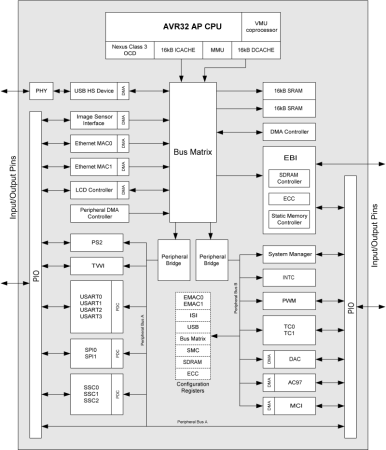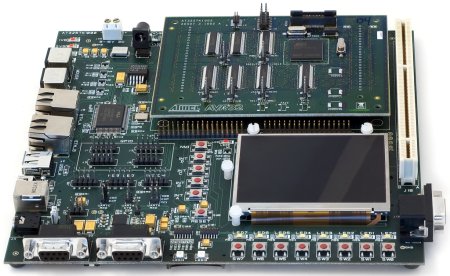High-efficiency SoCs boast new ISA, run Linux
Apr 3, 2006 — by LinuxDevices Staff — from the LinuxDevices Archive — 6 views Atmel is shipping the first chip in a line of SoCs (system-on-chip processors) aimed at improving battery life and performance in mobile phones, digital cameras, PDAs, automotive infotainment, set-top boxes, home entertainment systems, network switches/routers, and printers. The AP7000-series chips run Linux, and support C/C++ applications, and are based on a new “AVR32” core said to outperform competing 32-bit cores “in every EEMBC benchmark for performance and code density.”
Atmel is shipping the first chip in a line of SoCs (system-on-chip processors) aimed at improving battery life and performance in mobile phones, digital cameras, PDAs, automotive infotainment, set-top boxes, home entertainment systems, network switches/routers, and printers. The AP7000-series chips run Linux, and support C/C++ applications, and are based on a new “AVR32” core said to outperform competing 32-bit cores “in every EEMBC benchmark for performance and code density.”
Atmel says it developed its AVR32 core from the ground up to save power and maximize throughput. The core supports single-cycle load/store instructions, and high code density to reduce cache misses. A seven-stage pipeline and three parallel sub-pipelines support “automatic data forwarding and out-of-order execution,” Atmel says, while accurate branch prediction results in zero-penalty branches, the company says.
The AVR32's instruction set includes “single-cycle SAD, FFT, iDTC, vector multiplication, Viterbi butterfly, block cipher algorithms, parallel, and array arithmetic operations, as well as Java and RISC instructions,” according to an Atmel AVR32 whitepaper. “Single-instruction-multiple-date (SIMD) instructions include single-cycle vectored 8- and 16-bit parallel addition and subtraction with optional saturation or halving, averaging, Max/Min, absolute value, shift and add/subtract operations.”
The AT32AP7000 SoC, now shipping, is the first available chip in Atmel's AP7000 series of chips, all of which will be based on the AVR32 core. The AP7000-series chips are said to support lower clock rates than competing chips, resulting in an “immediate and proportional reduction in power consumption,” Atmel says.
When clocked at 120MHz, with a system bus speed of 60MHz, AP7000 chips need only 250mW to run a “full Linux operating system” and drive a QVGA TFT LCD, Atmel says. Configured thus, they can render 30fps (frames per second) QVGA (320×240) MPEG video streamed via its integrated Ethernet MAC, according to Atmel.
In addition to AVR32 core, which spares power through high code density and clock rate efficiency, the AP7000-series chips boast a multi-layer bus architecture that supports dynamic frequency scaling of four clock domains, including:
- CPU internal clock
- Bus matrix
- Bus bridge for high-speed peripherals
- Bus bridge for low-speed peripheral
Atmel says that slow peripherals operating on fast buses waste power in conventional designs; the AP7000 aims to avoid this by allowing its four power domains to be dynamically scaled independently of one another. For example, when running applications are inactive, but a Bluetooth or IrDA data transfer is under way, clocks for the CPU, bus matrix, and high-speed bridge can be shut down, while the clock for the slow speed bridge is maintained, the company says.
The AP7000 SoCs also feature a high level of integration, which spares power. For example, an on-chip USB 2.0 transceiver obviates external USB controller chips.

Atmel's AP7000 architecture diagram
(Click to enlarge)
Specifically, the AP7000-series chips integrate:
- Vectored multiplier co-processor
- 32KB on-chip SRAM
- 16KB each of instruction and data cache
- MMU
- DMA for high-speed peripherals
- Peripheral DMA controller that allows data to be transferred between peripherals and memories without wasting processor cycles
- 16-bit stereo audio DAC
- 2048×2048 pixel TFT/STN LCD controllers
- 480 Mbps USB 2.0 with on chip transceivers (PHY) — no external USB controller needed
- 2 x 10/100 Ethernet MACs
- PS/2 keyboard/mouse ports
- A wide assortment of serial interfaces:
- RS232
- USART
- AC97
- TWI/I2C
- I2S
- SPI
- “Several synchronous serial modules (SSC)” supporting most serial communication protocols
Atmel says that compared with multicore chips being developed on conventional architectures, the AP7000-series chips provide a “single-processor tool flow” that simplifies application development.
Starter kit
The company is shipping an STK1000 starter kit that includes a development board, Linux 2.6 kernel, and GNU tools supporting C/C++ application development. An available third-party C/C++ compiler from IAR Systems adds SIMD/DSP optimizations for C applications. Both compilers support in-line assembly, for tight-loop/inner-loop algorithmic optimizations, Atmel says.

The STK1000 starter kit's development board
(Click to enlarge)
Availability
The first device in the AP7000 family, the AT32AP7000, is available now in a 236-ball CABGA package, priced at $16.60 in 10K quantities. An STK1000 starter kit with a “fully-supported Linux 2.6 kernel” is also available, priced at $500. Atmel's mk-II JTAG ICE (in-circuit emulator), which supports the AP7000 chips is also available, priced at $299.
This article was originally published on LinuxDevices.com and has been donated to the open source community by QuinStreet Inc. Please visit LinuxToday.com for up-to-date news and articles about Linux and open source.